Boca Rio Golf Club
FL, USA
Green Keeper: Robert Randquist

Sand and wind are everywhere at Boca Rio, as indicated by this view down the 9th hole.
Like Scotland, coastal Florida possesses two essential ingredients for great golf: sandy soil and wind. Unfortunately, unlike Scotland, it possesses relatively mundane topography. There are exceptions such as Seminole Golf Club where Ross’s brilliant routing makes the most of the high ridges that form the east-west perimeter of the course. The picture from the elevated fourth green across the course and out to the Atlantic Ocean is one of pure golf and is an idyllic one at that. The sense of getting away from it all is complete.
Conversely, the balance of golf in Florida makes many traditionalists shutter. Zooming in a cart from one green to the next tee by passing between a row of condominiums robs the golfer of any sense of a connection with nature. And with the vast majority of Florida courses either resort or residential based, the game of golf rarely comes first.
However, there are a few places where golf still holds center stage, with one of the most famous being Pine Tree Golf Club, thanks in part to Ben Hogan’s 1962 proclamation about it being the greatest flat course in the world. In this age of dumbed down courses, Pine Tree still stands as the rigorous challenge that Dick Wilson intended and it attracts professional golfers as dues paying members to this day.
Not more than twenty minutes from Pine Tree, there is a similar 7,100 yard course whereby the golfer must drive the ball long and accurately, possess a strong aerial iron game, and be adept at recovering from green-side bunkers. The name of the course? Boca Rio Golf Club, but because Hogan never uttered a famous quote about it and because its 150 man membership prefers its privacy, few have heard of it.
However, many golf professionals in the Boca Raton – Palm Beach area appreciate its value, starting with its first head professional, Tommy Armour. Situated four miles from the ocean on a 195 acre block of land, Boca Rio has been strictly a golf club since its inception in 1967 ( five years after Pine Tree opened). There are no houses, swimming pools or tennis courts to contend with – the golfer is free to focus on his game.
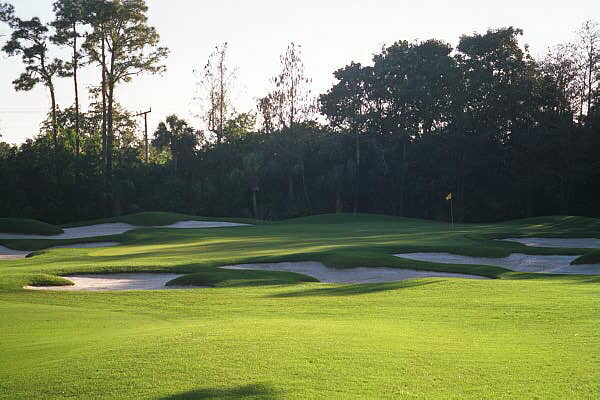
The angled, well guarded 2nd green highlights the challenging nature of the golf at Boca Rio.
Abe Deitch, an avid golfer from Pittsburgh and the driving force behind the formation of Boca Rio, was adamant when he selected Robert Van Hagge in 1967 to build a thorough and exacting test. To Von Hagge’s credit, he didn’t fall back on the excessive use of water to accomplish that goal. Unlike other architects who rely on water as a crutch to lend their design’s interest, Von Hagge only has water hard by the 1st and 17th greens. With just a few exceptions like to the right of the 18th fairway, there is little water in play on the entire course, making it a great relief from modern designs like Old Marsh where water seems a constant threat. Combined with the minimal use of rough, little time is wasted in searching for one’s ball.
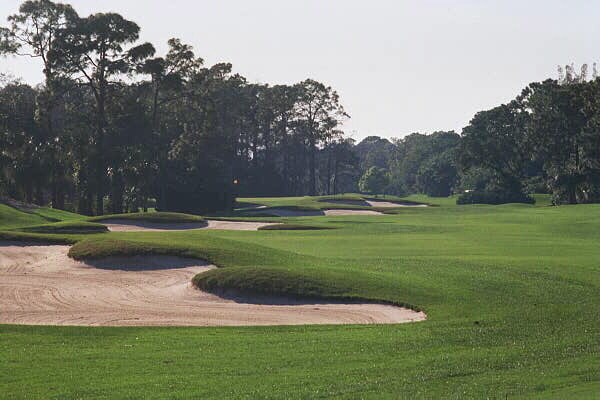
Interesting bunkering patterns, as opposed to water, create the strategy at Boca Rio. These echelon of bunkers must be crossed at some point during the play of the 585 yard 10th hole.
Finishing a round with the ball that one started with is a joy often reserved for the older, traditional courses associated with the northeast and midwest of the United States. Yet, the design of Boca Rio possesses other similarities with such traditional courses. Take its practical use of mounds for instance.
Countless courses (many in Florida) have rows of mounds that run parallel to the fairways. They offer no strategic value and often times don’t even hide the cart paths. The best that can be said of them is that sometimes they block out houses. Of course, the use of mounds in golf course design is over a century old in the United States but the mounds employeed by Walter Travis at Garden City GC were in play, the mounds used by Ross to the left of the first green at Essex County were a different form of hazard, and the mounds used by Leeds between the second and thirteenth fairways at Myopia Hunt were used to cover up stones to save the expense of carting them away.
Thus, the use of mounds in a functional capacity has long standing merit and such is the case at Boca Rio. For instance, the State of Florida decried that the noxious weed Brazilian Pepper Tree, Australian Pine Tree and Malelucabe eradicated. As a start, the club embarked on a program to rid the course of 90% of its interior Pepper Trees. However, the sheer volume of trees would have meant a removal bill of several hundred thousand dollars, far in excess of any budgeted amount. Thus, Pat Mucci Jr., the Green Committee Chairman at the time, suggested that a particular lake (that is out of play) be expanded and that the fill from the lake be used to cover the felled Pepper Trees. In a similar manner to Leeds at Myopia, much time and money was saved by the covering – as opposed to removal of- the unwanted debris.
Similarly, the board opted both to get rid of the marl under some fairways as it didn’t let the water permeate through and to kill its ormand fairways which had a purplish hue when dormant during the winter. Menthol bromide was used to kill the existing fairways, which were then covered with thousands of yards of plastic strips. When the club was ready to plant the 419 bermuda, the question became what to do with the plastic strips. Once again, the same Green Committee Chairman suggested burying them. A very attractive sand dune complex was created behind the 8th green and the thousands of yards of plastics were forever buried underneath.

Boca Rio enjoys a great variety of attractive backdrops behind its greens, as seen here at the 8th.
Other functional uses of mounds include one in the right side of the eighteenth fairway. If the player is willing to flirt with the water hazard to the right of the fairway, he is rewarded by hitting a ‘turbo-boost’ mound, which will propel his ball another 20 yards forward and open up the best angle into the green. Another use of a mound that is directly in play occurs two paces off the 1st green. Depending on how the ball catches it,the mound can send the ball either right and onto the green or left and into the lake.
Another attribute of the design is Von Hagge’s routing. The 1st and 2nd holes and 10th and 11th holes are the only consecutive long holes that head in the same direction, leaving the golfer to continually reassess the wind and its direction.
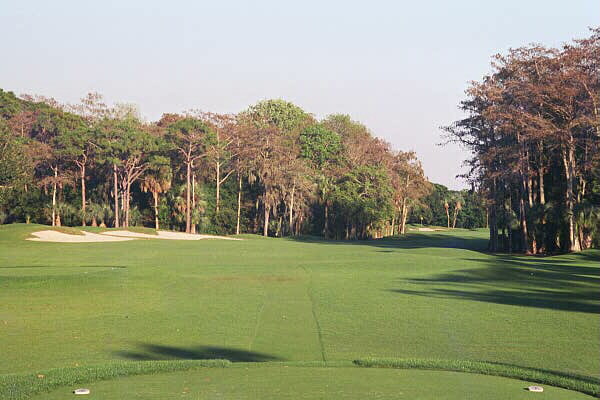
Florida law is such that little work can be done within 100 feet of the state protected cypress tree. With such considerations in mind, Von Hagge did an especially admirable job in routing the course. As seen here at the 8th, the first grove of cypress trees on the right helps call for a fade off the tee while the second grove son the left suggests that a draw would be ideal.
Having played on the PGA Tour, Von Hagge has a sense for what constitutes good golf at a high level. Just asPete Dye is fond of doing, Von Hagge asks the golfer on several holes to work the ball one way off the tee and the other way on his approach shot. For instance,the 410 yard fifth hole bends to the left but then the green is angled from front left to back right and suites a fade approach. The better player will relish the chance to show off his skill at Boca Rio, as we see below.
Holes to Note
First hole, 495 yards; Given the limited play, this reachable three shotter makes for an ideal start. The fairway is a full 45 paces wide and encourages all golfers to hit it. As makes perfect sense, the shot is the least taxing on the course. The plot then gets interesting as a golfer can a) have a go for the green in two, which is complicated by a grove ofcypress trees 100 yards shy of the green b) lay up beside the lake that borders the left side of the green and be left with a simple 90 yard pitch or c) ignore the lake altogether by laying back further and accepting a 130 yard shot in. If you are trying to ease into the round, the hole gives you the latitude to do so. If you spent time on the practice field beforehand and want to get the round off to a quick start, you can attempt that too. A great 19th hole as well, given its options.

When the northeast of the United States is blanketed by snow and ice, the club’s northern members take special delight in the idyllic view from the 1st tee.
Fourth hole, 365 yards; Should one lay back off the tee and accept a 130 yard approach shot into this green? Or should he try and fit his tee ball between the bunkers left and right and be left with only 100 yards in? Regardless, the sharpest pitched green from back to front on the course greets the golfer, which is saying something as the greens at Boca Rio enjoy verygood interior contours. Anything faster than 10.5 on the Stimpmeter would be silly.

The flag standing at attention lets the golfer know that his short iron approach to the 4th is going to be complicated by the ever present coastal winds.
Twelfth hole, 360 yards; A rarity in golf but this 360 yarder creates as many double bogeys as any another hole on the course. Many golfers elect to stay short of the three left hand fairway bunkers andare left with a 150-160 yard shot into the green. However, too many golfers follow such prudent tactics off the tee with an aggressive play into the green and that’s where the fun begins.The green issomewhat ‘T’ shaped, affording all kinds of interesting sucker hole locations.Many members have concluded toaim at the center of the green regardless of the day’s hole location.

Looks like a fairly straightforward approach shot? Wait til you see the hole in the slender neck on the front or on either the back left or right wing of the 12th green.
Fourteenth hole, 415 yards; A well conceived dog leg to the left, with the golfer tempted to carry the30 yard long inside bunker off the tee to shorten his approach shot. As with many holes at Boca Rio, the golfer needs to know where to miss his approach shot and in this case, it’s to the right as the green slopes well away from its left hand greenside bunkers.

If the golfer carries this bunker off the tee as opposed to laying up beside it, he is rewarded with a 40 yard shorter approach shot. Note the appealing false front to the green.
Fifteenth hole, 445 yards; Thestronger player delights at such an uncompromising hole at this stage in the round. A draw off the tee is ideal as the hole bends slightly to the left past several bunkers. The golfer is then confronted by a green that is wider than it is deep, unusual for a hole of this length. With bunkers both in front and behind and a green that is swift from back to front,the green complexmakeslittle attempt to accommodate anything but a high longiron shot. Unlike the disappointing fate of The Medalist Club one hour up I-95 whose original design is continually softened and compromised for the sake of ‘fairness’, the principal founder of the club Abe Deitch would be delighted tosee that the 15th’s raw challengehas never been reduced.

Do you have the ability to hit a high cut 3 iron to chase after this hole location at the 15th? One benefit of a wide green is in its course set-up flexibility - the approach is likely to call for a draw the next day.
Sixteenth hole, 540 yards; In this day of 300 yard drives, thetiger golfer is accustomedto having his way with three shot holes. A big drive and he figures to have a go at most par fives in two, with a relatively straightforward up and down if he misses the green. This is emphatically not the case at Boca Rio, which explains in partwhy Bernhard Langer’s 68 is still the course record.
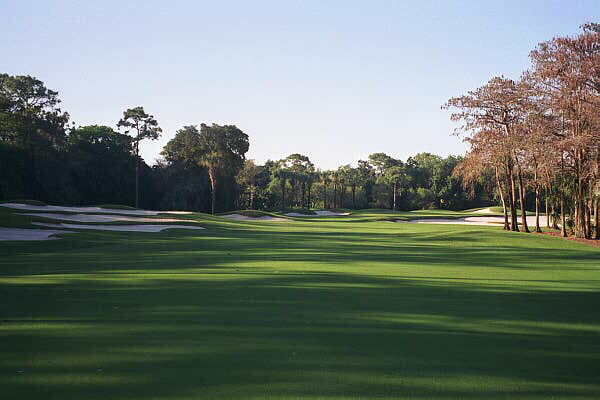
With a nest of bunkers cut into a hillside left and cypress trees right, the golfer has to carefully place his 2nd shot at the three shot 16th.
Seventeenth hole, 180 yards; Different architects produce different holes and one of the joys of golf isto stumble across a hole that reminds you of no other hole that you’ve ever seen. The 17th is just such a hole.Despite the hour glass shaped green being a mammoth 13,000 square feet,when the hole is located on the lower tier, it is not unusual to see an ace golfer aim 10 yards left of the green and hope for an up and down.

The unique green configuration at the 17th provides endless possibilities. If the hole is on the top tier, the golfer can use the mounds behind the green to feed the ball close to the back hole locations.
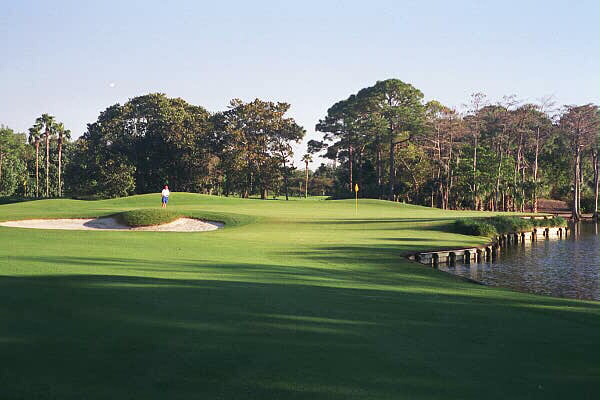
If the hole is on the harder lower tier, the golfer will rue the day he gets in the bunker as the resulting splash shot is across the narrowest part of the green, which in turn slopes into the lake.
Eighteenth hole, 425 yards; The Home hole heads back toward the ocean and as such, it generally plays into the prevailing wind.The already mentioned ‘turboe boost’ mound some 240 yards from the tee coupled with the pond on its right hand side gives the tee ball plenty of interest. However, the green complex steals the show. Once featured on the cover of Sports Illustrated in the late 1960s, it is connected with the 9th green and together, they cover some 19,000 square feet.The difference between a back left hole location and a front rightone can be as much as four clubsand again, the golfer must give thought to whereto miss it. Short siding the hole is never the play:a chipping area to the right of the greenis preferable if the hole is located on the left and conversely, if the hole is right, the left greenside bunkermay afford the easier up and down.

A perfect drive leaves this approach into the Home green. The player who can shape his shots has a distinct advantage at Boca Rio. In this case, the front right to back left diagonal angle favors a draw.
Von Hagge’s work is sure to impress anyone who plays Boca Rio as the course is full of challenge without ever overwhelming the golfer. Like Pine Tree, the course has a way ofidentifying the better player by the end of the match. Indeed, its similarities with Pine Tree as a player’s course should come as no surprise as Von Hagge worked for Dick Wilson out of his Delray Beach office foreight years until Wilson’s death in 1965. Von Hagge learned well from Wilson during such high profile projects as the Blue Course at Doral and Pine Tree, both completed in 1962, and incorporated much of what he learned at Boca Rio. By all accounts, it is his best work and deserves to be much better known.Pity Hogan didn’t play here too.
The End

